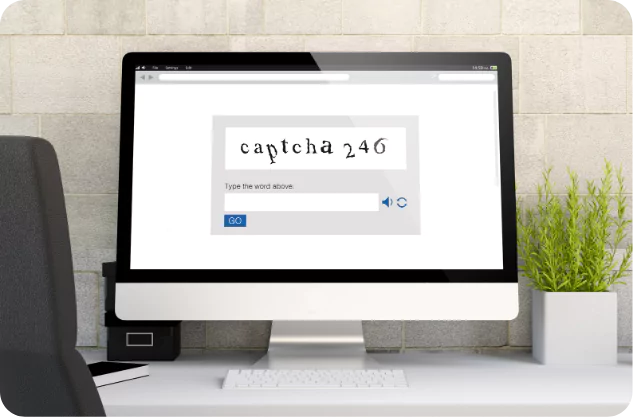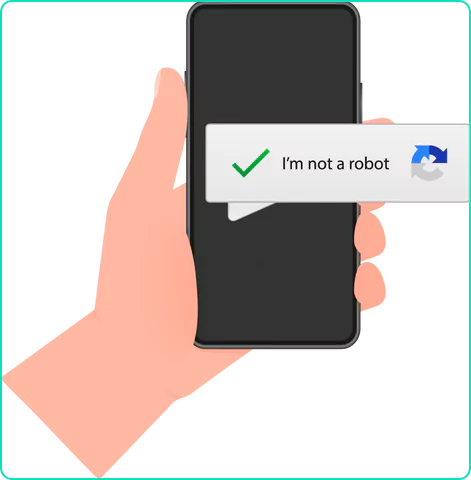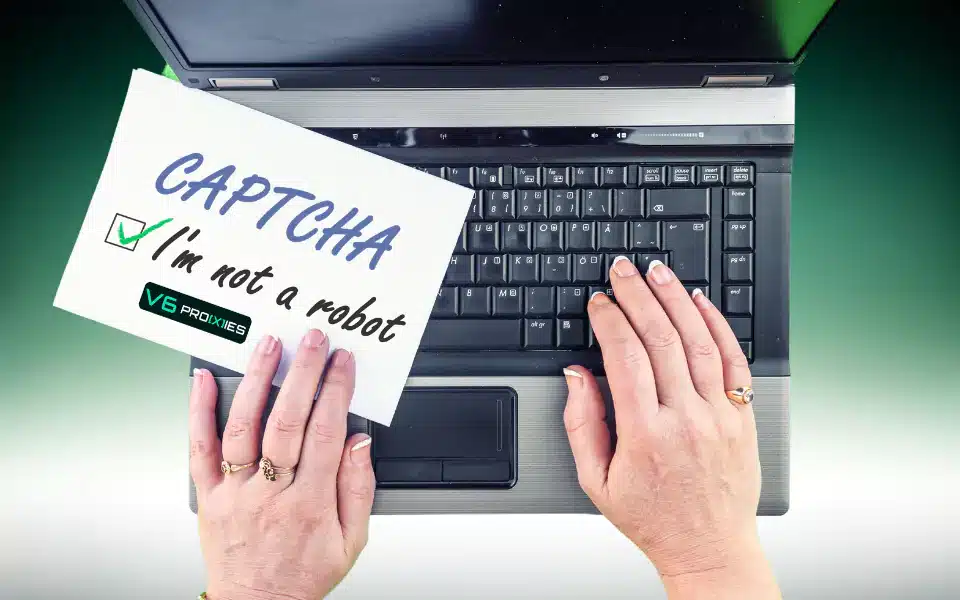CAPTCHAs are those annoying tests you have to pass on websites to prove you’re not a robot. They make you type distorted text, identify objects in images, or solve puzzles. But why are do the world need them, and how does a CAPTCHA work?
As you face these challenges regularly while browsing the web, you’ve likely encountered requests to select traffic lights in a picture or decipher warped text before you could proceed. These puzzles, known as CAPTCHAs, function as gatekeepers across numerous websites. Their fundamental purpose is to distinguish real users from automated bots.
This guide will make you understand how CAPTCHAs function, their various types, and explore methods for bypassing them under legitimate scenarios.
Table of Contents
What Is a CAPTCHA?
CAPTCHA stands for “Completely Automated Public Turing test to tell Computers and Humans Apart.” They are checks put in place to allow humans through while blocking automated bots and scrapers.
The main elements that define a CAPTCHA are:
- The Turing Test: A CAPTCHA is inspired by and related to the Turing test, proposed by Alan Turing, which was designed to determine if a machine can exhibit intelligent behavior indistinguishable from a human.
- Human-Computer Interaction: A CAPTCHA operates within the context of human-computer interaction, taking advantage of capabilities like visual perception, cognitive reasoning, and motor skills that are unique to humans.
- Human Interactive Proofs: A CAPTCHA functions as a type of human interactive proof, where the user must successfully complete a test to verify their human identity before gaining access.
The average person spends 10-30 seconds solving a CAPTCHA.

What Is The Turing Test?
The Turing Test is a method of determining whether a machine can demonstrate human intelligence by engaging in a conversation with a human without being detected as a machine. It was proposed by mathematician and computing pioneer Alan Turing in 1950.
The test is conducted in an interrogation room where a judge has a conversation with a human and a computer program without seeing them.
If the judge cannot tell which one is the human and which one is the computer based on the quality of their conversation, then the computer is considered to have demonstrated human intelligence. This test requires a controlled environment and involves evaluating the responses of the test subject to determine if they can fool the judge into believing they are human.
How Does CAPTCHA Work
CAPTCHAs work by presenting challenges that are relatively easy for humans but extremely difficult for current AI/machine learning technology. However, they just raise the bar – determined attackers can still try to bypass them.
Here’s an in-depth look at the mechanisms behind CAPTCHAs:
1. Text-Based CAPTCHAs:
These CAPTCHAs challenge users to type out distorted or obscured text. This task is difficult for bots due to the variations in fonts, colors, and complex backgrounds designed to interfere with optical character recognition (OCR) technologies. The constant evolution of these CAPTCHAs is a try for them to stay a step ahead of increasingly sophisticated bots.
2. Image-Based CAPTCHAs:
In these CAPTCHAs, users are asked to identify specific objects within images or solve puzzles that require image manipulation. The complexity and variability of visual elements capitalize on human proficiency in pattern recognition—a task that remains challenging for AI.
3. Audio CAPTCHAs:
These Captchas provide a spoken phrase against a noisy background that users need to transcribe. This type tests human auditory processing capabilities, which are more nuanced than current automated systems can handle effectively.
4. Interactive CAPTCHAs:
These require direct interaction, such as dragging items to designated spots or rotating objects to a specific orientation. Such tasks leverage human motor skills and cognitive decision-making, which are difficult for bots to replicate accurately. You can see this in action as the main Anti-bot mecanism Twitter (X.com) uses.
5. Adaptive Difficulty:
CAPTCHAs can dynamically adjust their difficulty based on the behavior of the user. If an interaction seems potentially automated, the CAPTCHA may increase in complexity, posing a tougher challenge to dissuade bot interactions.
Triggering Captchas: The Concept Of Invisible reCAPTCHA
Invisible reCAPTCHA is a version of Google’s CAPTCHA system introduced in 2016 that works in the background without requiring any direct interaction from the user.
Unlike other CAPTCHA systems that might ask users to select images or type distorted text, Invisible reCAPTCHA analyzes user behavior such as mouse movements, IP address, and browsing data passively when they submit a form on a website.
It automatically determines whether a user is a human or a bot without displaying any challenges, unless suspicious activity is detected, at which point it may prompt the user to solve a traditional CAPTCHA.

What Are CAPTCHAs Used For?
The internet serves as a vast source of information accessible to people from all walks of life, including students, researchers, teachers, and the general public. While this open access facilitates research and knowledge sharing, it also exposes websites and online services to various threats from malicious actors.
CAPTCHAs were introduced in 1997 as a security measure to protect websites against these threats. Their primary purpose is two-fold:
1. Preventing Automated Abuse
- CAPTCHAs help combat bots and scripts aimed at carrying out unauthorized activities like mass account creation, data scraping, and inventory hoarding.
- They help with prevention of opening a large number of orders on sites that offer free services like Gmail, Yahoo, etc.,
- They act as a barrier against automated systems attempting to harvest information such as texts, and images, or collect pricing details from websites.
- Captchas help with prevention of spams on forums and e-mails
- Validation of the online surveys is also a task CAPTCHAs help with.
2. Mitigating Malicious Attacks
- CAPTCHAs can help prevent Distributed Denial of Service (DDoS) attacks, where perpetrators attempt to disrupt web services by overwhelming them with traffic.
- They also counter efforts by unscrupulous individuals seeking to make illegal profits through activities like Inventory hoarding (e.g. ticket scalping) and reselling platfrom terms abuse (e.g. eBay stealth multiple accounts)
While CAPTCHAs may slow down legitimate research and data gathering activities to some extent, they are a necessary trade-off to safeguard websites from various forms of abuse and cyberattacks.
One notable example is the ticketing industry, where resellers often employ ticket buying bots to rapidly purchase large quantities of tickets for popular events. These tickets are then resold at higher prices, depriving genuine fans of fair access. To combat such practices, most ticketing companies implement CAPTCHAs on their platforms.
If You think they are exaggerating, read this: In 2013, Ticketmaster reported that bots bypassed CAPTCHA 60% of the time.

Using CAPTCHAs To Train Ai
CAPTCHAs were originally invented as a website security mechanism to distinguish humans from bots. However, their ability to leverage uniquely human skills has allowed them to be repurposed for collecting training data to improve AI capabilities in areas like image recognition (OCR), text digitization, and audio processing.
Using CAPTCHAs to train AI has become a sophisticated strategy employed by companies like Google to enhance their AI systems. Here’s how this works:
- Data Collection: When users solve CAPTCHAs, such as identifying distorted text, labeling images, or transcribing audio, their inputs are recorded. These CAPTCHAs often involve tasks like reading distorted text or identifying specific objects in a series of images.
- Dataset Building: The inputs from millions of users across the globe provide Google with a vast amount of data. Each correct user response confirms the identity or characteristics of an object in an image, the correct spelling in a distorted text, or the words spoken in an audio clip.
- Training AI Models: Google uses these verified inputs to train machine learning models. This training involves teaching the AI to recognize patterns or features in images, understand distorted texts, and process spoken language. The more data fed into these models, the better the AI becomes at accurately interpreting similar inputs.
How To Bypass CAPTCHAs? [6 differnet ways]
Bypassing CAPTCHAs, while generally discouraged and potentially illegal depending on the context and intent, remains a topic of interest both for security professionals seeking to bolster defenses and for those looking to understand CAPTCHA weaknesses. Here are 6 methods to bypass CAPTCHA systems:
1. CAPTCHA Solving Proxies
While individual CAPTCHAs are manageable, they become a huge obstacle at scale when automating processes across many websites. This is where CAPTCHA solving proxies come in.
CAPTCHA solving proxies cycle through millions of IP addresses, with advanced technology to automatically solve the latest visual and audio CAPTCHAs for you. This allows your bots to operate seamlessly even when hitting CAPTCHAs.
V6Proxies offers high-performance CAPTCHA solving proxy pools starting from just $260/month with a range of flexible plans. With 24/7 support, you can effortlessly overcome online restrictions.
Our Features enables you to:
- Access any website at scale without manual CAPTCHA solving.
- Bypass strict anti-bot measures with residential rotating proxies.
- Automate web scraping, account creation, inventory monitoring, etc.
- Use with all protocols (HTTP/S, SOCKS5) and IPv4/IPv6.
- Solutions for any use case – sneakers, tickets, data harvesting, rank tracking and more. Start Today!
2. OCR (Optical Character Recognition) Techniques:
For text-based CAPTCHAs, OCR software can sometimes be used to decode the characters. Despite distortions meant to complicate this process, advanced OCR tools equipped with machine learning can adapt and decode many variations with significant accuracy.
3. Machine Learning Models:
By training models on a dataset of CAPTCHA images labeled with their solutions, machine learning algorithms can learn to predict CAPTCHA answers effectively. These models can be particularly effective against image-based CAPTCHAs, where they identify and classify visual contents.
4. CAPTCHA Farms:
Human solvers, often working in low-wage regions, solve CAPTCHAs in real-time for a fee. These CAPTCHA farms have real humans who receive CAPTCHA challenges and return the solutions quickly, allowing automated systems to bypass checks with human-generated solutions.
5. Session Replay:
Techniques that involve replaying the interactions of a human user to pass the CAPTCHA challenge. By capturing the mouse movements, typing speed, and other interaction patterns of a human solving a CAPTCHA, bots can replay these interactions to pass as humans.
6. AI-Powered Captcha Decoding Tools:
Advanced artificial intelligence programs have been developed specifically to interpret and solve more complex CAPTCHAs, such as those involving logical puzzles or identifying abstract patterns in images. These tools continuously improve as they are exposed to more CAPTCHA styles.
Answers To Your FAQs
As usual, we collecte relevant questions and tried to answer them to make this guide your go-to CAPTCHA reference:
How To Correctly Enter a CAPTCHA?
To manually pass a CAPTCHA, you need patience and careful visual/audio perception. If stuck, request a new CAPTCHA as they are randomly generated each time.
What is hCAPTCHA?
hCAPTCHA (or Human CAPTCHA) is an advanced form of CAPTCHA developed by BYCloud, a cybersecurity company based in Vancouver, Canada. It is designed to be extremely difficult for current computer programs and bots to solve while remaining relatively straightforward for human users.
Unlike traditional CAPTCHAs that rely on distorted text or images, hCAPTCHA employs advanced cognitive challenges that leverage uniquely human abilities such as logic, reasoning, and multi-step problem-solving. These challenges often take the form of interactive puzzles or games that require users to follow a set of rules or instructions to complete them successfully.
Can bots bypass CAPTCHAs?
While very difficult, advanced bots integrated with CAPTCHA solving services can bypass CAPTCHA protection using techniques like OCR and machine learning.
What is a reCAPTCHA?
reCAPTCHA is a free service from Google that helps distinguish humans from bots on websites. The “re” in reCAPTCHA indicates a “Reverse Turing Test,” which uses simple puzzles that are straightforward for humans but challenging for computers. It utilizes advanced risk analysis to assess whether interactions are human-like or automated.
Types of reCAPTCHA challenges include:
- Checkbox reCAPTCHA: Users confirm they are not robots with a simple checkbox, while Google analyzes behavior in the background.
- Image Selection reCAPTCHA: Users select images matching specific criteria, like identifying traffic lights.
- Audio reCAPTCHA: Provides an audio challenge for users with visual impairments to transcribe distorted sequences.
reCAPTCHA’s adaptive risk analysis might skip the challenge for users it recognizes as likely human but increases difficulty if it detects bot-like patterns.
To get site keys to implement recaptcha on your website, you need to register your website with Google’s reCAPTCHA service.
How to add CAPTCHA to a website?
Most websites use third-party CAPTCHA providers like Google’s reCAPTCHA which provide codes to integrate into your site.
How much does reCAPTCHA cost?
Google’s reCAPTCHA is free for low volume websites. Higher volume corporate use has paid plans.
Related articles:



